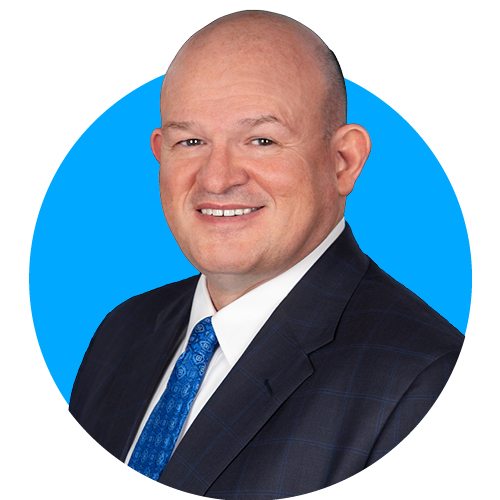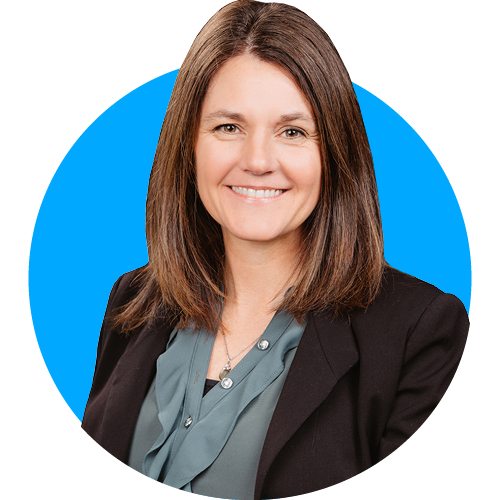Hal Higdon is Chancellor of the Ozarks Technical Community College System
Culture
Reaching the the Hidden Workers of Southwest Missouri
Which barriers are preventing you from finding and keeping employees? And what can you do about them?
by Lucie Amberg
May 2022

You may have heard that the Odyssey never describes anything as “blue.” It has 12,000 lines, and none of them mention a blue sky or a blue sea, nothing blue at all. There’s a lot of debate about this and many theories about what it might mean. To save you from diving down an internet hole, here’s a summary of the most popular theory: The Odyssey doesn’t describe anything as being blue because the ancient Greeks didn’t have a precise word for the color we call “blue.” And because there wasn’t a word for it, people didn’t register it as a distinct color. They were seeing it, but they weren’t recognizing it. Because blue wasn’t defined, it was kind of invisible.
I don’t know how valid this theory is; we’d need to ask a linguist or a neuroscientist—maybe both. But as a metaphor, it may be useful the next time your hiring process has you feeling blue. If you’re staring at a slate of open positions, wondering where all the qualified applicants have gone, it may help to consider how you’re defining “qualified.” For example, are you assuming aqualified applicant will come with a specific educational background or job history? Without a criminal record? If so, your definition of “qualified” may be camouflaging people who have the potential to meet your needs.
3 Simple Fixes
Which pieces of my screening process might be blocking applicants?
You know the applicant screening system that’s supposed to streamline your hiring process? It might be streamlining good applicants right out of your employment pipeline. People lead complex lives. They contend with limited educational opportunities. They put their careers on hold for a variety of reasons. They make mistakes. Applicant screening—particularly the automated kind—has a way of flattening out these complexities until they’re just barriers, separating people who want to work from the labor market. A recent study by Harvard Business School and Accenture estimated that 27 million job seekers in the United States are getting blocked by screening filters like educational requirements, employment history and criminal background checks. So what’s it like to move beyond these barriers?
1. Educational Background
As people attain higher levels of education, they accrue advantages in the job market. According to data from the U.S. Bureau of Labor Statistics, a person with an associate’s degree is more likely to find employment than a person with a high school diploma. A bachelor’s degree provides an extra advantage, and people with advanced degrees have the highest likelihood of being employed. But according to Hal Higdon, chancellor of the Ozarks Technical Community College System, if you’re expecting applicants to arrive fully packaged with all the education you’d like them to have, you may be falling into an outmoded way of thinking. “It’s no longer, ‘Train first, employ second,’” he says. “Now it’s, ‘Employ, train, train, promote’—all the way to retirement.”
Higdon recommends hiring workers for their character, work ethic and potential, then helping them develop over the course of their careers. He highlights CoxHealth and SRC Holdings Corp. as models of this approach. Krisi Schell, SRC’s executive vice president of human resources, says it’s part of the company’s promote-from-within culture. “We have a learning mindset,” she says. “And we provide the training and education to make that happen.” Some of SRC’s positions simply require specific education or certification, but whenever possible, Schell says, “We scour internally to see if someone within our organization has the basic skills in that area or a desire to learn.” If these employees are interested in pursuing training, SRC covers 100% of tuition costs.
Since 2008, SRC has been sending whole cohorts to OTC to earn associate’s degrees in manufacturing technology. Interested employees apply for consideration; their applications are reviewed by a committee of past program graduates and company leaders. The cohorts attend classes from 4 to 7 p.m., three nights a week. Because all the students work at SRC’s various divisions, they often forge connections within the organization. Schell says it’s a confidence builder, too. Once people know they can manage going to school while they’re working full time, they keep going, sometimes all the way to the master’s degree level.
This approach allows SRC to take a holistic view of applicants who are just beginning their careers. Entry-level workers don’t need to have earned all the education or training SRC might desire because the company is willing to play the long game with good employees. And given the price tag of going to school—average full-time tuition at a public, 4-year institution in Missouri clocks in around $9,000 per year—these educational benefits can become a recruiting tool. As Schell says, “We’ve got people who started on the shop floor and retired as executives.”
Higdon calls this “the continuum of training,” and he says 417-land’s unique advantages make it possible. If a business is too small to supply whole cohorts, it can seek out specific training from local institutions—whenever an employee needs such training to advance.
“A person may be our student three separate times in their lifetime,” Higdon says. “When they finish here, they may go over to Missouri State. Then they may get a master’s degree at Drury. If you’re a business within 100 miles of Springfield, all the things you need to get your workforce onboarded, trained and then trained again are right here.” Herschend Family Entertainment has similar goals for its employees and is utilizing a slightly different path to reach them. In February, Herschend rolled out its own educational platform, which makes more than 250 programs from various institutions available via an online portal called Grow U. On the portal, employees can find everything from high school completion programs to certificates, along with associate’s, bachelor’s and master’s degrees, and it’s available to full-time, part-time and seasonal staff from the first day of employment.
Deanna Partridge, Herschend’s vice president of talent development, says that Herschend covers 100% of 100 programs, including the cost of books and fees; for the remaining programs, the company covers up to $5,250 per year, the tax exempt limit. And it’s all paid up front by the company.
Feedback about Grow U has been “tremendous,” Partridge says. At press time, 500 employees had already taken the first step to begin using the portal. While Grow U comes with no strings attached—employees who use the benefit aren’t obligated to continue with Herschend for a certain period of time—Partridge says it supports retention by demonstrating Herschend’s commitment to its employees’ growth. The program is projected to cost $1–2 million each year, and “whether someone takes advantage of the benefit or not, I think they’re excited that we would invest so heavily in our employees,” she says.
“It’s no longer, ‘Train first, employ second. Now it’s, ‘Employ, train, train, promote’—all the way to retirement.”— Hal Higdon, Chancellor of the Ozarks Technical Community College System


Krisi Schell is Executive Vice President of Human Resources, SRC Holdings Corp.
“We’ve got people who started on the shop floor and retired as executives.”— Krisi Schell, Executive Vice President of Human Resources, SRC Holdings Corp.
2. Work History
Some employers are willing to relax educational requirements for applicants with meaningful work history. But what about applicants who are literally entry level—as in, they have no work history? It’s natural to feel nervous about hiring people who haven’t had a chance to develop soft skills, such as time management and follow-through, but if no organization takes a chance on applicants who are completely green, novice workers may get caught in a vicious “lack of experience” cycle.
Nonprofit Hive of the Ozarks is stepping in to help bridge this gap, with special emphasis on workers who have cognitive differences or differing abilities. Its Willard coffee shop, also called Hive of the Ozarks, preserves a staffing ratio that includes 50% typically-developing people and 50% people with differing abilities. Employees work 500-hour paid internships, a structure that allows Hive to train more people than it could on a conventional shift work model. And while employees are learning to serve up housemade granola, cookies and coffees, they’re also developing the soft skills that will launch them over the entry-level hump.
“This is a stepping stone to help you find a job you really want,” says Melissa Skaggs, director of Hive of the Ozarks. “The basic work skills are the same no matter where you work.” Considering how difficult it is to fill entry-level positions right now, it’s not surprising that two businesses have already reached out about hiring Hive workers once they’ve completed their internships. “They’ve told us: ‘We’ll take all of your employees,’” Skaggs says.
Hiring People with Differing Abilities
Tips From Melissa Skaggs of Hive of the Ozarks
1. Be specific. Make the employee responsible for clearly defined tasks, rather than sharing everything about the business, which can feel overwhelming.
2. Get creative. To preserve certain benefits, employees may have to limit the hours they work. If someone can only work a limited number of hours each week, consider deploying that person to cover lunches, breaks and other scheduling pain points.
3. Make the work visual. Set the employee up for success by using clear visual cues, like colored labels, to highlight important places and processes.
Interested in hiring Hive of the Ozarks staff or creating a program like it? Reach out to Melissa Skaggs.
3. Criminal Background Check
Since Springfield Leather Company’s founding, it has sold items to prison craft shops. This is why Chris Costa, senior director of operations, says the company has always viewed people who are incarcerated as good customers—and potentially, future employees. “People make mistakes,” Costa says. “That’s the tricky reality. You’ve probably made plenty—they’re just not written on a piece of paper for everyone to see.”
Through word of mouth, Springfield Leather has become known as a place where applicants who fear they’ll get screened out by a criminal background check can still score an interview. During the interview process, the company looks for character and humility and resists the impulse to hold applicants’ histories against them. Springfield Leather asks questions such as: “When you came out of prison, what did you learn? What are your goals? Who’s your support group? What is your life structure like now?” When people answer with openness and report having established support systems, Costa says there’s a good chance that they’re ready for an opportunity at Springfield Leather. He insists that the onboarding dynamic is the same for all employees, regardless of criminal background. Some new hires develop into wonderful team members, and some don’t. “When they start working, that’s when you find out,” he says. Generally, the employees who’ve been incarcerated are enthusiastic and eager for a fresh start. “They are extremely loyal, which is hard to buy,” he says.
Jeremy Hahn, executive vice president of Life360 Community Services, agrees. “Those who come to us with less than perfect backgrounds and come to us in sincerity, oftentimes they end up becoming fantastic employees,” Hahn says. Life360 hosts a wide range of service programs, so Hahn says it’s key to evaluate the need for criminal background checks on a position-by-position basis. For example, he says, Life360 is “ultra-careful” when filling positions that work with kids but more open when filling packing or processing roles. Given the impact of incarceration on American life—the United States incarcerates a higher percentage of the population than any other country, according to the Prison Policy Initiative—this approach may be part of solving workforce woes.
Working with People Who Have a History of Incarceration
Tips From Chris Costa of Springfield Leather Co.
1. Get candid. Ask straightforward questions about the applicant’s support system and goals. Look for open, honest answers.
2. Stay engaged. Once you’ve hired someone, preserve this open dynamic. Remain vigilant about signs of addiction, which can derail other employees who are committed to staying sober.
3. Don’t judge. In prison, even small infractions get punished. This dynamic can incentivize people to lie, so consciously create a different dynamic, one where people feel they can reach out when they’re struggling.
4. Nurture relationships. If you want more than a transactional relationship with employees—if you want them to put special effort into the company—be willing to put extra effort into them.
“People make mistakes. That’s the tricky reality. You’ve probably made plenty—they’re just not written on a piece of paper for everyone to see.”— Chris Costa, Senior Director of Operations at Springfield Leather Company

Chris Costa is Senior Director of Operations at Springfield Leather Company

Melissa Skaggs is the Director of Hive of the Ozarks
“This is a stepping stone to help you find a job you really want. The basic work skills are the same no matter where you work.”— Melissa Skaggs, Director Hive of the Ozarks
3 Complicated Challenges
How are big-picture issues undermining Workers?
Workers who have no trouble soaring through applicant screening filters may still get tripped up by cracks in our societal structures. Challenges with child care, mental health and transportation have grown so large; they’re undercutting people who might otherwise thrive in the workforce. But 417-landers—businesses, individuals and nonprofits—are offering solutions.
1. Child Care
According to nonprofit Child Care Aware of Missouri (CCAMO), our state has lost 11,628 child care slots since the beginning of the COVID-19 pandemic. This loss is apparent in the anxiety of working parents. But while the need for child care feels acute at this moment, it’s been building for a long time. That’s the reason Robert Low, president and founder of Prime, Inc., created the Prime Kids Learning Center 23 years ago. In this in-house daycare facility, kids of Prime employees interact in the gym, classrooms and outdoor play space. The company cafeteria brings them breakfast, lunch and afternoon snacks each day. On-site medical care and security set parents’ minds at ease.
Employees who utilize the Learning Center pay a weekly fee that’s in line with the cost of other Springfield, Missouri daycare programs. It offers extended hours—kids can arrive as early as 6 a.m. and stay as late as 6:30 p.m. for no extra charge. There are emotional benefits, too. Parents find comfort in knowing their children are well cared for, close by. And by being part of the Prime complex, kids get early exposure to the idea that work is a rewarding part of adult life. “I enjoy coming here every day, so I feel like exposing my kids to these interactions shows them that work can be fun,” Adam Mulligan, fixed asset analyst at Prime, says.
Anna Messick, director of the Learning Center, says the goal is to alleviate stress for employees. “Parents don’t have to worry about bringing lunch or anything,” she says. “It’s all provided here at Prime.” In a 24/7, 365-day business like transportation, this is particularly beneficial, Mulligan says, and it’s worth the financial cost Prime incurs for the Learning Center. Without an on-site solution like this one, working parents have to source child care on their own. Greene County’s licensed capacity is 9,303, according to CCAMO. That means there are 9,303 possible child care slots for the 13,112 kids under age 6 in our county who have working parents. And this shortfall of 3,809 child care slots is the best-case scenario, according to CCAMO CEO Robin Phillips. Child care workers are in such short supply right now that most programs are only able to operate at 65–70% of their capacity, Phillips says.
The equation gets even tougher in rural counties. In Barry County, for example, there are 161 slots for 1,075 kids under age 6 with working parents. That’s seven kids for each slot—assuming the programs were able to operate at full capacity. The Life360 Preschool hopes to alleviate some of this stress. As part of the Life360 Resource Center in Monett, the preschool offers affordable child care centered around the concept of family support. With an on-site family coordinator, parents get help with things like bedtime routines and vacation budgets.
Parents are required to work volunteer hours at the preschool, and although Life360 strives to keep costs low, there are fees. This structure reflects the organization’s philosophy that “everyone needs to contribute to the community,” according to Jeremy Hahn, executive vice president of Life360 Community Services. The organization is willing to help out with these costs through programs like “back to work” scholarships, which help parents cover the gap between the day they start a job and need child care and the day they receive their first paycheck. If a business wants to subsidize child care for an employee, it can fund a specific scholarship.
Like most child care centers, Life360 Preschool prioritizes serving kids who need full-time care. This makes sense; it’s the most efficient way to deploy precious resources and benefit the most people. But where does this leave part-time workers? Or people who have part-time help from a grandparent and need supplementary care? Or people who are willing to work unusual hours or extra shifts—if they can find child care?
Christina Ford hopes Kids Inn, a drop-in center that’s set to open this summer in Springfield, can provide a solution. As she envisioned Kids Inn, Ford drew on her own experience as a mom in Nashville, where she used drop-in care. When her husband became head coach of Missouri State University’s men’s basketball team, she saw the need for something similar in 417-land.
“Every family is different and has different needs,” Ford says. Once parents complete Kids Inn’s brief registration process, they can take advantage of the service whenever they need it. Spaces will be available on a first-come/first-served basis. And instead of requiring a weekly or monthly financial commitment, Kids Inn will operate as a “pay as you go” service. Since Kids Inn will be open until 8 p.m. on weeknights and 10 p.m. on Fridays and Saturdays, Ford hopes it will help parents plug gaps in their child care plans.
“Parents don’t have to worry about bringing lunch or anything. It’s all provided here at Prime.”— Anna Messick, Director of the Prime Kids Learning Center

Anna Messick is Director of the Prime Kids Learning Center

Christina Ford is the Founder of Kids Inn
“Every family is different and has different needs.”— Christina Ford, Founder of Kids Inn
2. Mental Health
More than 20% of U.S. adults report experiencing “high levels of psychological distress,” according to the Pew Research Center. In Greene County, this translates to roughly 47,000 people, which means every business likely includes employees who’d say they’re in distress.
Of course, you might not know that someone’s feeling this degree of stress, which is why Dr. Shelly Farnan-Moore of Burrell Behavioral Health says it’s critical to make mental health central to workplace culture. With Burrell’s Be Well Community, Farnan-Moore says she hopes we’ll “change our entire culture so that it’s not ‘if we need brain health supports.’ We all have a brain and will all need brain health supports.”
Through the Be Well Community, organizations can arrange virtual or in-person sessions with Burrell experts. Farnan-Moore says this isn’t only about employee welfare; it’s good for the bottom line.
“Historically, successful leaders were smart, had grit and were business savvy,” she says. “We went to work and we kept work separate from life. Now, our incoming employees are expecting something different. Now the sign of a leader is: How much am I willing to understand those that I lead?”
Supporting Mental Health in the Workplace
Tips from Dr. Shelly Farnan-Moore of Burrell Behavioral Health
1. Make it a priority. Shift the culture so that supporting brain health is as natural as supporting other health needs.
2. Schedule ongoing training. “Our business outcomes are directly affected by the brain health of our employees,” Farnan-Moore says.
3. Take care of yourself. Leaders often ask Burrell to care for their teams. Once Burrell begins working with a company, Farnan-Moore says: “The first person who realizes how much they’ve been holding in is always the leader, the owner.”
Looking for expertise? Reach out to Burrell Behavioral Health’s Be Well Community at 417-761-5000.
“Now the sign of a leader is: How much am I willing to understand those I lead?”— Dr. Shelly Farnan-Moore, Vice President of Be Well Initiatives at Burrell Behavioral Health

Dr. Shelly Farnan-Moore is Vice President of Be Well Initiatives at Burrell Behavioral Health

Brian Fogle is President of Community Foundation of the Ozarks
“One person typically worked four days a week at a medical center [in Springfield], and was willing to work one day a week in Ozark to get extra hours […] It was $17.60 each way to get back and forth.”— Brian Fogle, President of Community Foundation of the Ozarks
3. Transportation
In the wake of the pandemic, Community Foundation of the Ozarks (CFO) sought ways it might help workers who were struggling to thrive in the labor market. CFO zeroed in on transportation because of stories like this one:
“One person typically worked four days a week at a medical center [in Springfield], and was willing to work one day a week in Ozark to get extra hours,” says CFO President Brian Fogle. “She didn’t have a driver’s license and had to take a cab. It was $17.60 each way to get back and forth. That ate up [the pay] from two of the eight hours she was working.”
To help with costs like these, CFO launched the Let’s Get to Work Fund in December. At its launch, the fund had $382,000 to distribute to organizations that could help workers with transportation expenses. It’s now received more than $600,000 in total gifts. In addition to partnering with nonprofits, CFO has collaborated with the Springfield Business Development Corporation (SBDC) to help employers access funds on behalf of their employees. Jen Johnson, chief of staff of the Springfield Area Chamber of Commerce, is part of the team that administers the SBDC funds. The SBDC has already administered two rounds of $30,000 grants. A third grant of $30,000 just became available, Johnson says, and it’s now open for applications.
“From the employer side, we knew transportation was a challenge,” Johnson says. “The rapid response indicates that the need is deeper and more complex than I realized.”












